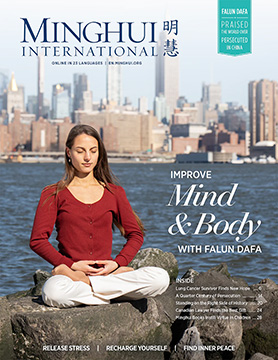Lakeside Leader, July 2, 2003, p.15
[Front page: Thumbnail photo of Bernice Smith, following text]
"Some Kinuso residents say they've found a new alternative to pain killers."
A few short months ago, Bernice Smith of Kinuso was suffering from a host of ailments. They included fibromyalgia, high blood pressure, diabetes and osteoarthritis. She got around slowly and painfully with the help of a back brace and a knee brace.
At 59-years, Bernice had known health problems most of her adult life and wasn't looking forward to an end to it. She relied heavily on a variety of medication, but was never free of pain or discomfort.
Three months ago, everything changed.
"I have healed in mind, body and spirit," she says. "I am back at work and pain free."
No more braces, no more meds, and she feels fine.
"It's a miraculous thing," she says. "The most beautiful thing that's ever happened to me in my life."
Bernice credits her newfound health to her practice of Falun Gong, or Falun Dafa as it's sometimes called. It's the Chinese art of exercise and meditation that has been in the news in recent years due to the persecution of its practitioners by the government of the People's Republic of China. Falun Gong apparently has millions of followers in that country, and is growing in popularity around the world.
So what is it exactly? What in the world could have produced the kind of results that Smith claims?
It seems almost too simple. The practitioner improves his or her physical health through a series of exercises, which include meditation. The other component of the practice is self-improvement through studying the teachings of the Falun Gong founder, Li Hongzhi. He urges the practitioners to let go of harmful attachments and to strive for truthfulness, compassion and forbearance in their lives.
"We have to work on these things to be able to heal ourselves," explains Bernice.
It certainly seems to work for her.
Jan Jekielek -- currently working in Slave Lake -- is another Falun Gong practitioner. He has a similar story to tell about the powerful healing effects of the practice.
Three years ago, Jan suffered from a rare nervous system disorder called Guillian-Barre Syndrome. It made walking difficult, caused him to be "tired all the time," with depression as an unhappy side effect.
Jan says he was fairly skeptical of Falun Gong to begin with. He tried it with little in the way of expectations.
"I got into it because I was looking for something that would make me feel better," he says.
The results surprised him.
"Very rapidly I was better than 100 percent," he says.
His health problems disappeared, including the depression, and he quit a 10-year smoking habit very easily.
"I just didn't feel like it any more," he says.
Jan typically spends at least 45 minutes per day doing the Falun Gong exercises and/or studying. There is no prescribed amount of practice, he says, nor is their any institutional structure that the practitioner feels obliged to belong to or support. There is no leadership per se, Jan says, nor any Falun Gong treasury, a factor he considers "very important."
"There's a strong emphasis on finding your own path in it," he says.
How fast Falun Gong is growing in Alberta and Canada is hard to tell. But with testimonies like these, it's not hard to see why interest is perking up, especially in places like Kinuso, where people can see the change in Bernice Smith. The more exposure the better, as far as she is concerned.
"It's all good," she says. "You just feel good. I'd recommend for people to practice (it)."
All content published on this website is copyrighted by Minghui.org. Minghui will produce compilations of its online content regularly and on special occasions.
Category: Falun Dafa in the Media









